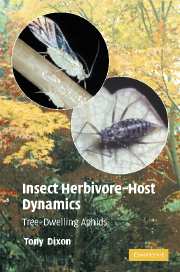Book contents
- Frontmatter
- Contents
- Preface
- 1 Introduction
- 2 Tree-dwelling aphids
- 3 Trees as a habitat: relations of aphids to trees
- 4 Trees as a habitat: relations of aphids to their natural enemies
- 5 Carrying capacity of trees
- 6 Aphid abundance
- 7 Population dynamics
- 8 Risky dispersal
- 9 Seasonal sex allocation
- 10 Aphids and tree fitness
- 11 Rarity, conservation and global warming
- Epilogue
- References
- Species index
- Subject index
11 - Rarity, conservation and global warming
Published online by Cambridge University Press: 08 August 2009
- Frontmatter
- Contents
- Preface
- 1 Introduction
- 2 Tree-dwelling aphids
- 3 Trees as a habitat: relations of aphids to trees
- 4 Trees as a habitat: relations of aphids to their natural enemies
- 5 Carrying capacity of trees
- 6 Aphid abundance
- 7 Population dynamics
- 8 Risky dispersal
- 9 Seasonal sex allocation
- 10 Aphids and tree fitness
- 11 Rarity, conservation and global warming
- Epilogue
- References
- Species index
- Subject index
Summary
Common species tend to be taken for granted and excite little interest, except when they become extremely abundant. Rare species, however, tend to attract more attention especially if they are large and/or colourful. Insects rarely fall into this category, and however rare are unlikely to become the subject of a conservation programme. That is, for most people, for example, one species of aphid is much like another and many are pests so why should one want to conserve them. Hopefully, insects will eventually be regarded as beautiful and fascinating, and worth conserving in their own right (Holloway, 2003), but this is unlikely except for a few large and/or colourful species. Meantime, however, insect conservation is likely to have to depend on the conservation of ‘flagship species’ or ‘umbrella species’, which are usually mammals, to safeguard certain habitats that incidentally include many other species of organisms, especially insects.
RARITY
Although rare insects are unlikely to excite the interest of conservationists they could be good subjects for studying rarity. Early in the twentieth century Garthside (1928) stated ‘one of the outstanding facts is the extremely large number of species which occur in very small numbers’. This sort of observation attracted the attention of biomathematicians like Williams (1964) who thought that a mathematical model that closely fits the observed data would increase our theoretical understanding of rarity and result in further tests and experiments.
- Type
- Chapter
- Information
- Insect Herbivore-Host DynamicsTree-Dwelling Aphids, pp. 162 - 173Publisher: Cambridge University PressPrint publication year: 2005



